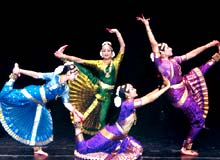History
Indian Dance
Dances of India

India is a land of diversities. Various climatic conditions have made India a diverse country. In all spheres of Indian life diversities are clearly visible. These diversities have made the Indian culture a unique one. Like all other aspects of life, the dance forms of India are also varied and different. There are many types of dance forms in India, from those which are deeply religious in content to those which are performed on small occasions.
The Indian dances are broadly divided into Classical dances and folk dances. The Classical dances of India are usually spiritual in content. Though the folk dances of India are also spiritual and religious in content but the main force behind the folk dances of India is the celebratory mood. Dances are a form of coherent expression of human feelings. Like the Indian culture, Indian classical dances are equally diverse in nature. There are numerous classical dance forms in India and innumerable folk dances. Each dance form can be traced to different parts of the country. Each form represents the culture and ethos of a particular region or a group of people.
The most popular classical dance styles of India are Bharatnatyam of Tamil Nadu, Kathakali and Mohiniattam of Kerala, Odissi of Orissa, Kathak of Uttar Pradesh, Kuchipudi of Andhra Pradesh and Manipuri of Manipur.
Indian Classical Dances
Indian classical dance has a distinct character that reflects the great cultural and traditional endeavor. The forms of Indian dance have transcended beyond the fences and socio-cultural hindrances. Exponents of the Indian classical dance believe that it has the caliber of creating a new and disciplined lifestyle. The Indian Classical Dance is often regarded as the form of worship and meditation. The performers of Indian Classical Dance, despite of the background and forms, have played a crucial role in presenting India to the forefront of the World stage.
Bharatnatyam
Bharatnatyam is one of the most popular classical Indian dances. Bharatnatyam is more popular in South Indian states of Tamil Nadu and Karnataka. Bharatnatyam dance is almost 2,000 years old. It is believed that Bharatnatyam was revealed by Lord Brahma to Bharata, a famous sage who then codified this sacred dance in a Sanskrit text called the Natya Shastra. The Natya Shastra is one of the fundamental treatises on Indian drama and aesthetics.
Kathak
Kathak is one of the most important classical dances of India. Kathak is said to be derived from the word katha, meaning "the art of storytelling." The Kathak dance form originated in north India and was very similar to the Bharatnatyam dance form. In ancient India, there were Kathakars or bards who used to recite religious and mythological tales to the accompaniment music, mime and dance.
Kathakali
Kathakali is the classical dance form of Kerala. The word Kathakali literally means "Story-Play". Kathakali is known for its heavy, elaborate makeup and costumes. In fact, the colorful and fascinating costumes of Kathakali have become the most recognized icon of Kerala. Kathakali is considered as one of the most magnificent theatres of imagination and creativity. Kathakali dance presents themes derived from the Ramayana, the Mahabharata and other Hindu epics, mythologies and legends.
Kuchipudi
Kuchipudi is one of the classical dance forms of the South India. Kuchipudi derives its name from the Kuchipudi village of Andhra Pradesh. In the seventeenth century the Kuchipudi village was presented to the Brahmins, who were experts in staging dance and drama. Kuchipudi exhibits scenes from the Hindu Epics, legends and mythological tales through a combination of music, dance and acting. Like other classical dances, Kuchipudi also comprises pure dance, mime and histrionics but it is the use of speech that distinguishes Kuchipudi's presentation as dance drama.
Manipuri
Manipuri is one of the six major classical dances of India. Manipuri dance is indigenous to Manipur, the North eastern state of India. The Manipuri dance style is inextricably woven into the life pattern of Manipuri people. The most striking part of Manipur dance is its colorful decoration, lightness of dancing foot, delicacy of abhinaya (drama), lilting music and poetic charm. The Manipuri dance form is mostly ritualistic and draws heavily from the rich culture of the state of Manipur.
Mohiniattam
Mohiniattam is a classical dance form of Kerala. Mohiniattam is derived from the words "Mohini" (meaning beautiful women) and "attam"(meaning dance). Thus, Mohiniattam dance form is a beautiful feminine style with surging flow of body movements. Mohiniattam dance in Kerala developed in the tradition of Devadasi system, which later grew and developed a classical status.
Odissi
Odissi is one of the famous classical Indian dances from Orissa state. The history of Odissi dance is almost two thousand years old. Odissi is a highly inspired, passionate, ecstatic and sensuous form of dance. Like most of the South Indian classical dances of India Odissi too had its origin in the Devadasi tradition. The state of Orissa has a great cultural history.
Indian Folk Dances
India is a land of varied cultures and traditions. Diversities in all spheres make the Indian culture quite unique. Indian folk and tribal dances are product of different socio-economic set up and traditions. Indian folk and tribal dances are simple and are performed to express joy. In India we have festivals and celebrations virtually every day. This has added to the richness of Indian culture. Since every festival is accompanied by celebration, folk dances have become an integral part of our social milieu.



